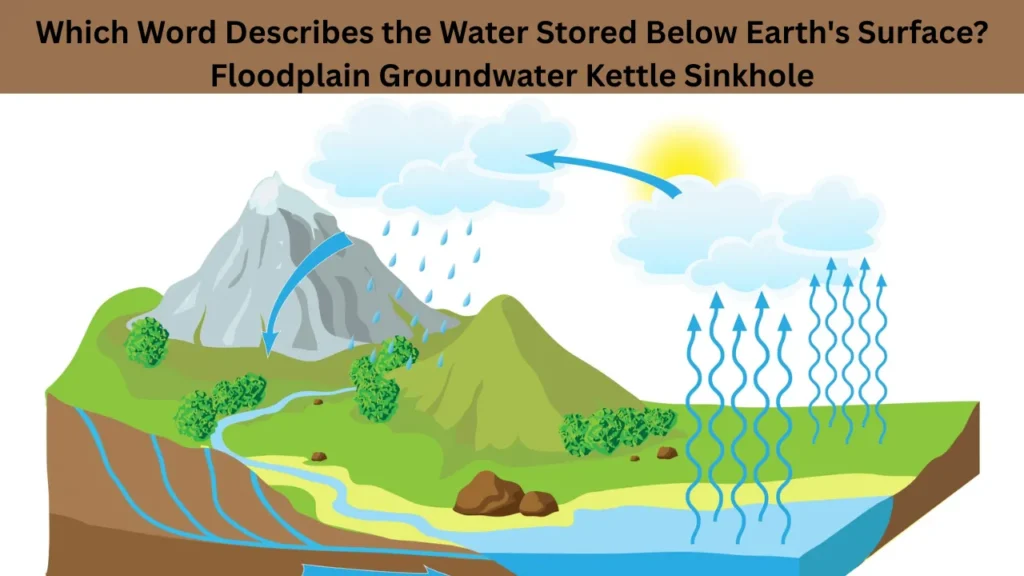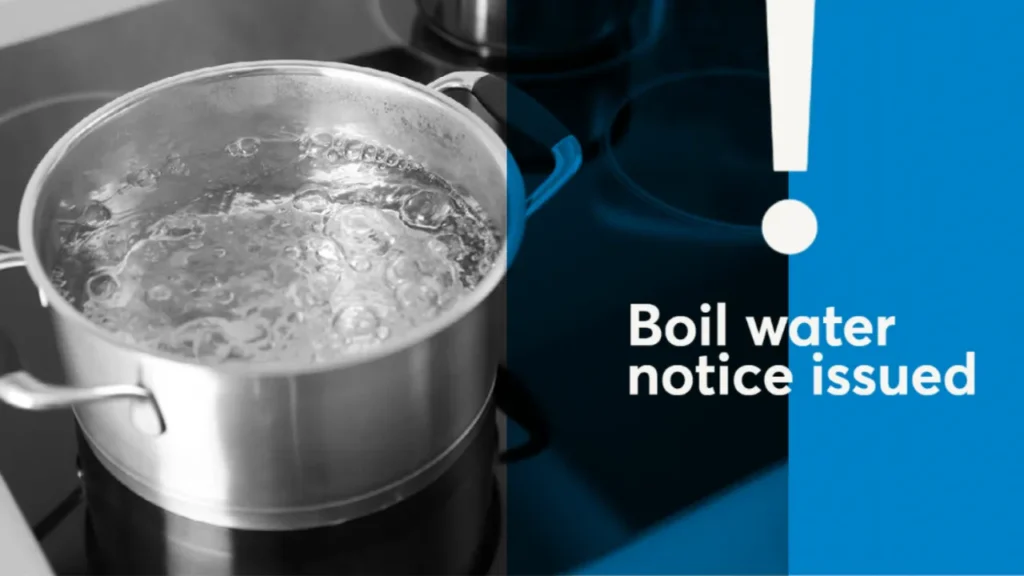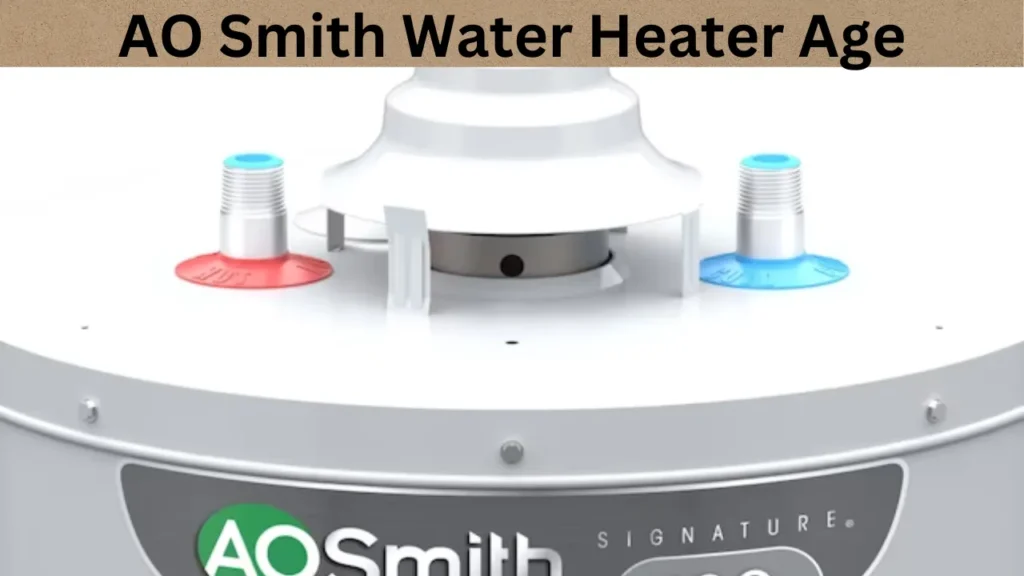When answering the question, which word describes the water stored below Earth’s surface? floodplain groundwater kettle sinkhole, the correct choice is groundwater. This word represents water located beneath the Earth’s surface in soil pores and rock cracks. The other options—floodplain, kettle, and sinkhole—refer to surface features that are unrelated or only indirectly related to water stored underground.
In this blog, we’ll explain each term, compare them, and explain why groundwater is the only correct answer.
Also Read: cenpok.com
What Is Groundwater?
Groundwater is water that fills the cracks and spaces in underground soil, sand, and rock. This water is stored in formations called aquifers.
Aquifers can hold huge amounts of water. They supply wells and springs, especially in rural areas. This water enters the ground through rain or melted snow. It slowly moves through soil and rock until it gathers in these underground storage spaces.
Many people across the world depend on groundwater for drinking, farming, and industrial use. Unlike lakes or rivers, groundwater is hidden but makes up a large portion of the world’s fresh water.
Also Read: Doctorhub360.com Neurological Diseases: Symptoms, Treatment
What Is a Floodplain?
A floodplain is the flat area of land next to a river. It floods when the river overflows during heavy rain. Sediments carried by the river settle in the floodplain, making the soil rich and good for farming.
But, when we ask which word describes the water stored below Earth’s surface? floodplain groundwater kettle sinkhole, the floodplain doesn’t fit. A floodplain is above the surface. It may get wet during floods, but it does not store underground water like an aquifer.
Also Read: Destin Water Temperature: A Complete Guide for Visitors
What Is a Kettle?
A kettle is a low area in the ground, often filled with water. It forms when a glacier leaves a block of ice buried in the ground. When that ice melts, the land sinks and forms a kettle hole, which can become a kettle lake.
These lakes are common in areas where glaciers once existed. They hold surface water, not water that’s underground. Therefore, they don’t answer the question, which word describes the water stored below Earth’s surface? floodplain groundwater kettle sinkhole.
Also Read: https://techzoneelectronics.com Finance: Smart Payment
What Is a Sinkhole?
A sinkhole is a hole in the ground caused when the rock below the surface dissolves. Rainwater can slowly eat away rocks like limestone. When the rock disappears, the ground above it may collapse and form a sinkhole.
Sometimes, sinkholes can reveal groundwater, but they are not the water source themselves. They are more like pathways to it. This is why they do not answer the question correctly.
Also Read: AO Smith Water Heater Age: Check, Maintain, Replace
Comparing the Options
Let’s take a look at how these four terms compare:
| Term | What It Is | Is It Underground Water? |
|---|---|---|
| Groundwater | Water beneath Earth’s surface stored in aquifers | Yes – this is the correct answer |
| Floodplain | Flat land near rivers that floods | No – it is a surface feature |
| Kettle | Depression formed by melting glacier ice | No – it holds surface water |
| Sinkhole | Ground collapse from dissolving rock | No – may expose water but not store it |
From this table, it’s clear that only groundwater correctly answers the question, which word describes the water stored below Earth’s surface? floodplain groundwater kettle sinkhole.
Why Is Groundwater Important?
Groundwater is one of the Earth’s most important natural resources. It provides more than half of the world’s drinking water.
It also:
- Keeps rivers and lakes from drying out during dry months.
- Helps farmers grow crops through irrigation.
- Keeps ecosystems alive, especially in forests and wetlands.
Because groundwater is hidden, it is often overused without people knowing. This can lead to wells drying up and damage to the land, like subsidence, where the ground sinks.
Where Is Groundwater Found?
Groundwater is found in aquifers, which are layers of rock and soil that can hold and carry water. These aquifers may be shallow, lying just a few feet below the surface, or deep, located hundreds of feet underground. The water in these spaces is held by the tiny gaps between sand, gravel, or rock.
There are two main types of aquifers:
- Unconfined aquifers: Water can move freely in and out. These are closer to the surface.
- Confined aquifers: Sandwiched between layers of rock or clay, they’re deeper and harder to access but often contain cleaner water.
The water table is the top of the groundwater layer. It rises during rainy seasons and drops in dry times or during heavy water use.
How Is Groundwater Collected?
Groundwater is collected through wells, which are holes drilled into the ground. A pump brings the water up to the surface. In rural areas, homes often have their own private wells. Cities may also have well fields that pull water from aquifers to serve thousands of people.
There are two types of wells:
- Shallow wells, which reach water close to the surface.
- Deep wells, which reach into deeper aquifers for more secure and cleaner water.
Can Groundwater Run Out?
Yes, groundwater can run out if it is used faster than it is replaced by rainfall. This is called overdraft. In some places, water tables (the level of water underground) are dropping. It takes years for water to refill deep aquifers, so careful use is very important.
Fun Facts About Groundwater
Even though it’s hidden, groundwater is everywhere beneath your feet. In some deserts, ancient groundwater lies far below the surface. Scientists call this fossil water because it’s been there for thousands of years.
Also, groundwater can move very slowly, sometimes just a few feet per year. This slow movement helps filter the water, making it cleaner.
Groundwater and Climate Change
Climate change affects groundwater in several ways:
- Less snow and earlier snowmelt reduce long-term water supply.
- Longer droughts mean more water is pumped from the ground.
- Heavier rainfall, while good for recharge, may cause floods that do not soak in properly.
These shifts can make groundwater less reliable, especially where water use is already high..
How Is Groundwater Monitored?
Governments and scientists monitor groundwater using observation wells, satellites, and ground sensors. They track:
- Water levels
- Water quality
- Recharge rates
In the U.S., the US Geological Survey (USGS) plays a big role in watching over groundwater. This data helps cities, farmers, and companies use water wisely.
How to Conserve Groundwater
Simple actions help protect groundwater:
- Turn off taps when not in use
- Use rainwater for gardens
- Avoid overwatering lawns
- Fix leaks quickly
- Reduce chemical use outdoors
Every drop saved is water left underground for future generations.
Final Answer to the Main Question
To fully wrap up, let’s revisit the question:
Which word describes the water stored below Earth’s surface? floodplain groundwater kettle sinkhole?
The correct answer is:
Groundwater
The other options—floodplain, kettle, and sinkhole—refer to surface features or landforms. While sinkholes may connect to underground water, they are not the stored water itself.
Summary Table
Here’s a final summary to help remember the differences:
| Term | Water Location | Is It Underground Storage? |
|---|---|---|
| Groundwater | Below Earth’s surface | Yes – this is the correct word |
| Floodplain | On surface, near rivers | No |
| Kettle | On surface, shallow lake | No |
| Sinkhole | Surface depression, may connect to water | No |
Final Thoughts
Now you know the answer to the question, which word describes the water stored below Earth’s surface? floodplain groundwater kettle sinkhole. The answer is groundwater, which supports life, helps grow food, and sustains ecosystems. It is a hidden yet vital resource we must protect and understand.
Want to learn more about aquifers or how to conserve groundwater? Stay tuned for more simple science blogs that explain the wonders beneath your feet.



